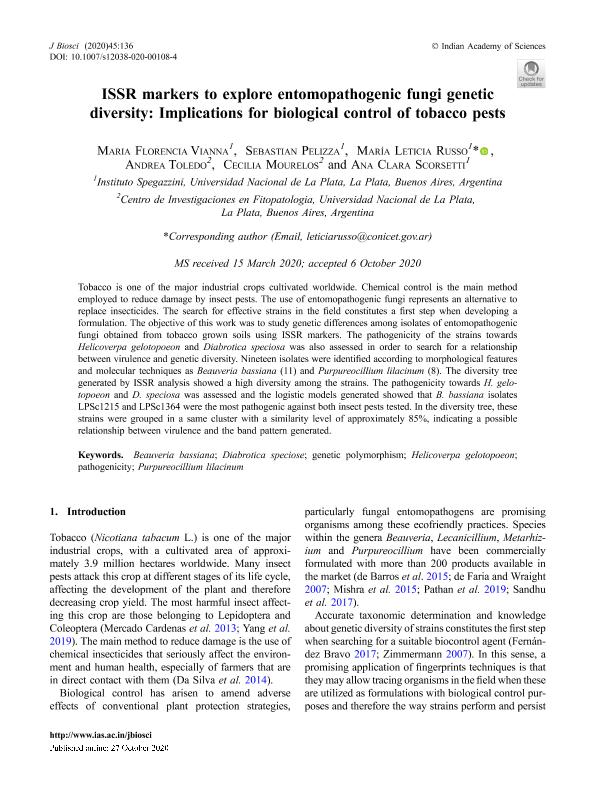Mostrar el registro sencillo del ítem
dc.contributor.author
Vianna, María Florencia

dc.contributor.author
Pelizza, Sebastian Alberto

dc.contributor.author
Russo, María Leticia
dc.contributor.author
Toledo, Andrea Vanesa

dc.contributor.author
Mourelos, Cecilia Alejandra

dc.contributor.author
Scorsetti, Ana Clara

dc.date.available
2021-03-04T15:20:58Z
dc.date.issued
2020-10
dc.identifier.citation
Vianna, María Florencia; Pelizza, Sebastian Alberto; Russo, María Leticia; Toledo, Andrea Vanesa; Mourelos, Cecilia Alejandra; et al.; ISSR markers to explore entomopathogenic fungi genetic diversity: Implications for biological control of tobacco pests; Indian Academy of Sciences; Journal of Biosciences; 45; 1; 10-2020; 1-11
dc.identifier.issn
0250-5991
dc.identifier.uri
http://hdl.handle.net/11336/127423
dc.description.abstract
Tobacco is one of the major industrial crops cultivated worldwide. Chemical control is the main method employed to reduce damage by insect pests. The use of entomopathogenic fungi represents an alternative to replace insecticides. The search for effective strains in the field constitutes a first step when developing a formulation. The objective of this work was to study genetic differences among isolates of entomopathogenic fungi obtained from tobacco grown soils using ISSR markers. The pathogenicity of the strains towards Helicoverpa gelotopoeon and Diabrotica speciosa was also assessed in order to search for a relationship between virulence and genetic diversity. Nineteen isolates were identified according to morphological features and molecular techniques as Beauveria bassiana (11) and Purpureocillium lilacinum (8). The diversity tree generated by ISSR analysis showed a high diversity among the strains. The pathogenicity towards H. gelotopoeon and D. speciosa was assessed and the logistic models generated showed that B. bassiana isolates LPSc1215 and LPSc1364 were the most pathogenic against both insect pests tested. In the diversity tree, these strains were grouped in a same cluster with a similarity level of approximately 85%, indicating a possible relationship between virulence and the band pattern generated.
dc.format
application/pdf
dc.language.iso
eng
dc.publisher
Indian Academy of Sciences

dc.rights
info:eu-repo/semantics/openAccess
dc.rights.uri
https://creativecommons.org/licenses/by-nc-sa/2.5/ar/
dc.subject
BEAUVERIA BASSIANA
dc.subject
DIABROTICA SPECIOSE
dc.subject
GENETIC POLYMORPHISM
dc.subject
HELICOVERPA GELOTOPOEON
dc.subject
PATHOGENICITY
dc.subject
PURPUREOCILLIUM LILACINUM
dc.subject.classification
Micología

dc.subject.classification
Ciencias Biológicas

dc.subject.classification
CIENCIAS NATURALES Y EXACTAS

dc.title
ISSR markers to explore entomopathogenic fungi genetic diversity: Implications for biological control of tobacco pests
dc.type
info:eu-repo/semantics/article
dc.type
info:ar-repo/semantics/artículo
dc.type
info:eu-repo/semantics/publishedVersion
dc.date.updated
2021-02-18T15:45:09Z
dc.journal.volume
45
dc.journal.number
1
dc.journal.pagination
1-11
dc.journal.pais
India

dc.journal.ciudad
Bangalore
dc.description.fil
Fil: Vianna, María Florencia. Consejo Nacional de Investigaciones Científicas y Técnicas. Centro Científico Tecnológico Conicet - La Plata; Argentina. Universidad Nacional de La Plata. Facultad de Ciencias Naturales y Museo. Instituto de Botánica Spegazzini; Argentina
dc.description.fil
Fil: Pelizza, Sebastian Alberto. Consejo Nacional de Investigaciones Científicas y Técnicas. Centro Científico Tecnológico Conicet - La Plata; Argentina. Universidad Nacional de La Plata. Facultad de Ciencias Naturales y Museo. Instituto de Botánica Spegazzini; Argentina
dc.description.fil
Fil: Russo, María Leticia. Universidad Nacional de La Plata. Facultad de Ciencias Naturales y Museo. Instituto de Botánica Spegazzini; Argentina
dc.description.fil
Fil: Toledo, Andrea Vanesa. Consejo Nacional de Investigaciones Científicas y Técnicas. Centro Científico Tecnológico Conicet - La Plata; Argentina. Universidad Nacional de La Plata. Facultad de Ciencias Agrarias y Forestales. Departamento de Ciencias Biológicas. Centro de Investigaciones de Fitopatología. Provincia de Buenos Aires. Gobernación. Comisión de Investigaciones Científicas. Centro de Investigaciones de Fitopatología; Argentina
dc.description.fil
Fil: Mourelos, Cecilia Alejandra. Consejo Nacional de Investigaciones Científicas y Técnicas. Centro Científico Tecnológico Conicet - La Plata; Argentina. Universidad Nacional de La Plata. Facultad de Ciencias Agrarias y Forestales. Departamento de Ciencias Biológicas. Centro de Investigaciones de Fitopatología. Provincia de Buenos Aires. Gobernación. Comisión de Investigaciones Científicas. Centro de Investigaciones de Fitopatología; Argentina
dc.description.fil
Fil: Scorsetti, Ana Clara. Consejo Nacional de Investigaciones Científicas y Técnicas. Centro Científico Tecnológico Conicet - La Plata; Argentina. Universidad Nacional de La Plata. Facultad de Ciencias Naturales y Museo. Instituto de Botánica Spegazzini; Argentina
dc.journal.title
Journal of Biosciences

dc.relation.alternativeid
info:eu-repo/semantics/altIdentifier/url/http://link.springer.com/10.1007/s12038-020-00108-4
dc.relation.alternativeid
info:eu-repo/semantics/altIdentifier/doi/http://dx.doi.org/10.1007/s12038-020-00108-4
Archivos asociados
